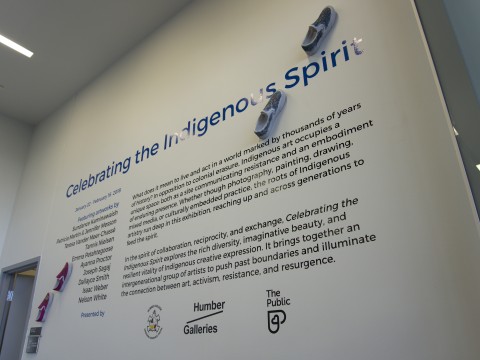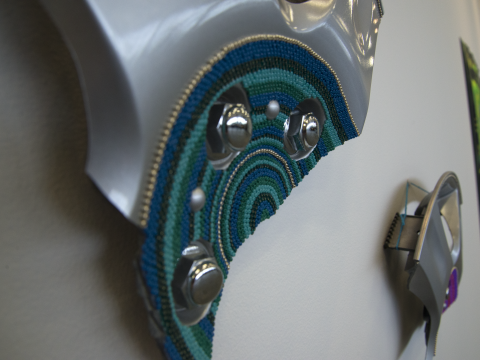Sundance Kaminawaish, Nephew, Digital Photograph
Image courtesy of the artist
What does it mean to live and act in a world marked by thousands of years of history? In opposition to colonial erasure, Indigenous art occupies a unique space: both as a site communicating resistance and an embodiment of enduring presence. Whether through photography, painting, drawing, mixed media, or culturally embedded practice, the roots of Indigenous artistry run deep in this exhibition, reaching up and across generations to feed the spirit.
In the spirit of collaboration, reciprocity, and exchange, Celebrating the Indigenous Spirit, a group show taking place at North Space from January 22 to February 16, 2018, explores the rich diversity, imaginative beauty, and resilient vitality of Indigenous creative expression. It brings together an intergenerational group of artists to push past boundaries and illuminate the connection between art, activism, resistance, and resurgence.
Celebrating the Indigenous Spirit Artist Bios
Tannis Nielsen is a Métis woman of Anishnawbe and Danish descent with twenty years of professional experience in the arts, cultural and community sectors, and ten years teaching practice at the post-secondary level.
In 2006, Tannis’s dissertation focused on the oral histories of her Mother Merle Monkman and her Grandmother Catherine Boucher as a means of asserting the need for localized Indigenous contexts to be inserted accurately within the structures of the academy by visually illustrating the negative consequence of colonial trauma on Indigenous cultures, lands, languages, familial relationships, and memory.
Tannis has served on the Aboriginal Engagement Committee at UBC-O and has sat as Advisor to the Equity and Diversity Committee at OCAD-U, a member of the Toronto Native Community History Project and is the past President of The Association for Native Development in the Performing and Visual Arts (A.N.D.P.V.A.) Tannis currently teaches in the painting and drawing stream at OCAD-U.
Joseph Sagaj is from the remote community of Neskantaga, approximately 300 km north of Thunder Bay, Ontario. He graduated in Fine Arts at the Ontairo College of Art & Design in 1985 and has had numerous private and public commissions which include logo designs, murals and illustrations.
In 2017, Joseph completed seven painting of “Seven Stages of Life and The Seven Grandfather Teachings” for the Ministry of the Attorney General, Aboriginal Justice Division, which are prominently displayed in their office. Joseph currently lives and works in Toronto.
Sundance Kaminawaish is an Anishinaabe man from the small community called Sachigo Lake located in Northwestern Ontario. He is a Humber student in the Advertising and Graphic Design program who has a passion for photography with a stronger focus on landscape photography.
Patricia Martin is multi-faceted Anishinaabe-kwe artist whose current practices include painting, ink, drawing, dessert baking and singing. Patricia’s painting explore mindfulness, imagined landscapes and visualizations of aural cacophony. Using art to solidify healthy thinking as well as contain and move forward from destructive patterns, Patricia invites viewers to interpret the layers of brush strokes, fingerprints and ramblings in her work.
Jennifer Messon is a Toronto-based artist. She enjoys painting, beading, mural making, photography and exploring different mediums of art while connecting with her culture.
Emma Petahtegoose is Atikamkesheng Anishnawbek, from Robinson-Huron Treaty Territory, and a graphic design student at Humber College. Emma began painting with water based paints at a young age, advancing to acrylic canvases and masonite over time. The collaboration of urban settings and cultural background influences how Emma sees the world, a reality that is conveyed through her art.
Ayanna Proctor is a leather artisan, freelance illustrator, and an enrolled member of the Piscataway Conoy Tribe of the Chesapeake Region. Her illustrations primarily focus on natural scenes that remain unscathed and undisturbed. A deeply rooted sense of belonging to the wilderness came from hiking and living in New England as well as time spent as a youth traversing the Shenandoah Valley.
This appreciation carried over into her art, where she viewed an assortment of rugged landscapes trekked both physically and mentally. Through the use of strictly grayscale, she hopes to convey the aesthetic aspect of the isolation and solace she finds deep in the woods.
Dallayce Smith is a First Nations painter, carver and filmmaker from the Asihihik and Klaune Lake area. In 2013, she joined the beginners carving program at Northern Cultural Expressions Society where she apprenticed under Tlingit artists Calvin Morberg and Jared Kane.
Dallayce draws much of her inspiration from her heritage and her spiritual connection to the land. In 2015, her journey took her to Toronto to explore other mediums outside of her First Nations culture.
Isaac Weber At an early age in life, Isaac Weber found himself in a foster family. As an Anishinaabe child pushed out by the system and its competing agenda, Isaac lost connection with his culture and community. After sailing across the world as a sailor for an oil company, Isaac grew up in the outskirts of Rotterdam exploring urban city life.
Exposed to art through graffiti, art class, and graphic design school, he lived in spite of oppression, drawing his vision on the world. He focused on political and social awareness; and since then has never moved too far from the drawing board, his canvas workstation, or his back pack full of spray paint and serious passion.
Nelson White is a Mik’maq artist and member of the Flat Bay Band from Flat Bay, Newfoundland. Nelson attended the Visual Arts program at Bay St. George Community College. After a brief career in advertising, Nelson had a long administrative career in professional sports and the non-profit sector. He is now a working artist, having his pieces exhibited frequently throughout Canada and the United States.
Teresa Vander Meer-Chasse is a proud member of the White River First Nation in Beaver Creek, Yukon and a member of the Aboriginal Curatorial Collective, Yukon Art Society and Squamish Arts Council. Though self-taught, her beadwork is inspired by strong women and the support of the caring men in her life. She defines herself as an Upper Tanana visual artist, incorporating her culture in all the work she creates. Theresa is not afraid of being different and ensures each piece she creates is unique and imaginative.
Gallery Hours
Monday - Friday 10AM - 4PM
Opening reception: Thursday, February 8th, 4 - 6PM
Exhibition Photos







